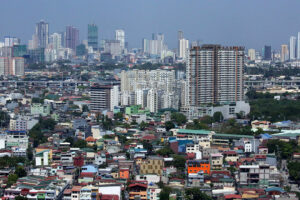EVEN as the Philippine banking system has remained resilient, the International Monetary Fund (IMF) said risks in the real estate sector and consumer credit still require closer monitoring and could prompt the central bank to intervene.
“Financial stability risks remain contained. The banking system has sufficient liquidity and capital buffers, and nonperforming loans (NPL) are low,” an IMF spokesperson told BusinessWorld in an e-mail.
Latest data from the Bangko Sentral ng Pilipinas (BSP) showed the banking industry’s NPL ratio eased to a three-month low of 3.3% in March.
“However, parts of the commercial real estate sector have seen persistently high vacancies and falling rents, and NPLs for housing loans remain elevated,” the IMF said.
Property consultant Colliers Philippines expects the vacancy rate for residential property in Metro Manila to hit 26% by yearend, while office vacancies are projected at 22% this year amid condominium oversupply and slow take-up of unsold units.
The BSP in its latest Financial Stability Report noted the “rising NPLs in the real estate sector.”
The NPL ratio for residential real estate was at 6.82%, while commercial real estate NPLs were 2.18% as of September 2024. The bulk (62.5%) of the real estate loan portfolio consists mostly of commercial loans.
The BSP also earlier said the mid- and low-cost housing segments, which account for a large part of residential real estate loans, have driven the rise in NPLs.
Consumer loans are also another area that the BSP needs to keep an eye on, the IMF said.
“The rapid growth in consumer credit, though a relatively small portion of banking assets, warrants close monitoring,” it said.
BSP data showed outstanding loans of universal and commercial banks rose by 11.8% to P13.19 trillion in March from a year ago.
Consumer loans to residents increased by 23.6% in March to P1.64 trillion, mainly due to the 28.8% jump in credit card loans to P959.43 billion.
The central bank must also be prepared to step in, when necessary, the multilateral institution said.
“The BSP should be ready to adjust macroprudential policy in line with developments in the financial cycle to preempt the buildup of vulnerabilities,” the IMF said.
In the same Financial Stability Report, the BSP said that the financial system’s real estate loan exposure will require “closer monitoring amid evolving market conditions.”
Banks’ real estate exposure ratio rose to 19.75% as of end-December from 19.55% at end-September.
This as total investments and loans extended by Philippine banks and trust departments to the real estate sector grew by 5% to P3.31 trillion as of end-December from P3.15 trillion in 2023.
The BSP monitors lenders’ exposure to the real estate industry as part of its mandate to maintain financial stability. — Luisa Maria Jacinta C. Jocson
